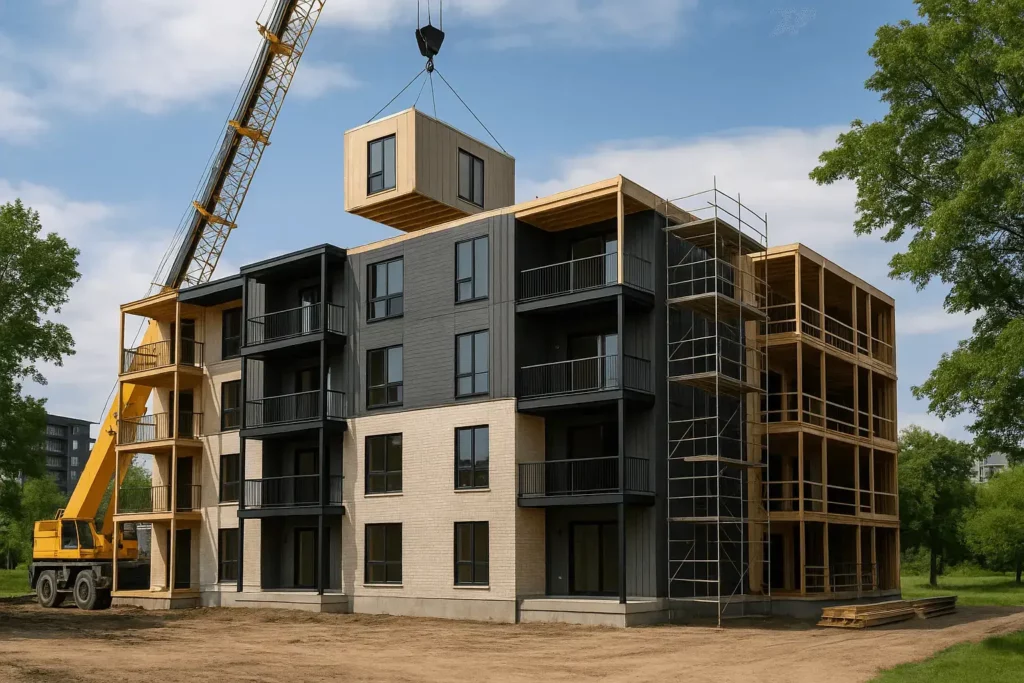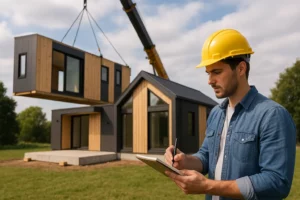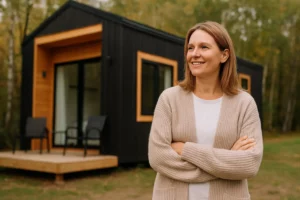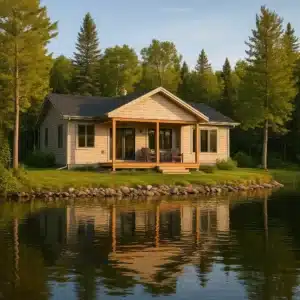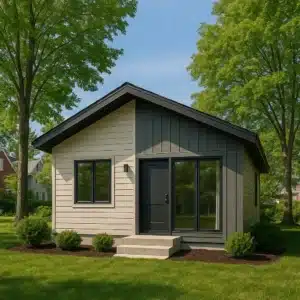Prefabricated multi-housing makes it possible to offer affordable, sustainable housing delivered in record time, while maintaining high quality standards.
With increasing pressure on the rental market, rising interest rates and labor shortages, prefabrication is emerging as a concrete alternative to traditional construction.
How multi-unit prefabrication works
In prefabricated construction, the units are factory manufactured, often in the form of complete modules including structure, insulation, plumbing and electricity.
Meanwhile, the construction site is preparing the foundation. Once the modules are delivered, they are assembled on site in a few days using a crane.
This industrial approach eliminates most delays and uncertainties related to weather, coordination of subcontractors or supplies.
Promising prospects for prefabricated multi-housing in Quebec
According to the newspaper Business, a report of McKinsey (October 2024) identifies the modular construction among the 18 global high-growth industries, alongside artificial intelligence and green technologies.
In Quebec, the government also believes in the potential of modular technology: the minister France-Élaine Duranceau provides for the creation of 500 prefabricated housing units by 2026, intended for low-income households. (Business, 2025).
Key benefits for developers and investors
1. Deadlines reduced by almost half
Thanks to parallel production (factory + construction site), developers can deliver a building 30 to 50 % faster.
This speed accelerates the return on investment and allows rental income to be generated sooner.
2. Better controlled project costs
Costs are set before production. In the factory, everything is planned: materials, labor, equipment, logistics.
This limits budget overruns and provides a predictability rare in conventional construction.
3. Consistent and controlled quality
Each module is assembled using standardized processes and subject to rigorous inspections.
Prefabrication reduces human error, leaks, and performance variations between units — a major asset for sustainability and resale.
Finally, workers work indoors, year-round, in a safe and productive environment.
4. Flexible and scalable design
Quebec manufacturers now offer a complete range of configurations:
-
Duplexes and triplexes with independent entrances
-
Small buildings with 4 to 8 apartments
-
Stacked modular multi-residential projects
Each project can be adapted according to the topography, the client's needs and the desired architectural style (contemporary, Scandinavian, rustic, urban, etc.).
5. A reduced ecological footprint
Prefabricated construction sites generate less waste and consume less energy. Prefabrication reduces the construction waste up to 90 % and minimizes the building's exposure to the elements.
Additionally, buildings are often designed to exceed energy efficiency standards through uniform insulation and high-performance materials.
For a developer, this not only reduces long-term operating costs, but also makes it easier to obtain environmental certifications (Novoclimat, LEED, etc.).
A lever to respond to the housing crisis
Municipal and provincial governments are actively seeking solutions to accelerate the creation of rental units.
Prefabricated multi-housing offers a concrete response to these challenges:
-
Faster construction without compromising quality; ;
-
Reduced costs, therefore potentially more affordable rents; ;
-
Ability to mass produce several similar buildings in the same development.
Some regions of Quebec, such as Mauricie, the Laurentians and Saguenay–Lac-Saint-Jean, are already beginning to see this type of project emerge thanks to partnerships between manufacturers, developers and municipalities.
Who is this an interesting option for?
-
Real estate developers wishing to build a rental portfolio with rapid returns.
-
Private investors wanting to diversify their real estate portfolio with a sustainable and profitable product.
-
Municipalities seeking to densify their territory with turnkey and eco-responsible projects.
-
Individuals considering a multi-generational duplex or triplex.
A driver of territorial development
Municipalities and the Quebec Housing Corporation (SHQ) are now banking on this approach to accelerate housing creation.
Modular projects allow you to densify intelligently urban environments, by maximizing the land value of a plot of land.
👉 A plot of land that once housed a simple duplex can now accommodate a complete building of 12 to 24 modular housing units, doubling or tripling its potential value.
This is an ideal approach for developers looking to make their underutilized land profitable.
Limits to consider
Despite its advantages, prefabricated multi-unit housing comes with some challenges:
-
THE municipal regulations may limit height or density depending on zoning.
-
THE transport of modules requires easy access for heavy machinery (truck and crane).
-
THE changes during the project are more expensive than traditional construction, because everything is planned in advance.
However, for well-prepared developers, these constraints are more than offset by the overall time and cost savings.
Prefabricated multi-housing: a solution for the future in Quebec
Prefabricated multi-unit housing not only represents a natural evolution of residential construction in Quebec — it marks a true paradigm shift.
By combining speed, sustainability and cost-effectiveness, this approach offers a concrete response to the housing crisis while raising market quality standards.
For developers, investors and municipalities, investing in prefabrication means building smarter, reducing financial risks and actively participating in the creation of modern, accessible and sustainable living environments.
It is a vision focused on the future of Quebec, where each plot of land and each project contributes to more efficient, greener and more humane real estate development.
